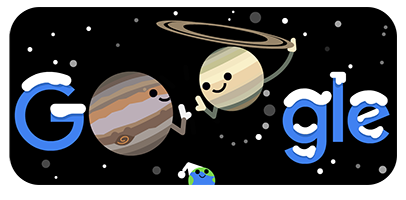Winter solstice Great Conjunction: Google Doodle celebrates ‘Christmas Star of 2020’
Merging of Jupiter and Saturn in 21 Decembers’s night sky is speculated to be the same source of light which became known as the Star of Bethlehem

Google is marking the winter solstice and appearance of the so-called Christmas star with its latest Doodle.
The winter solstice on 21 December is the shortest day of the year in the Northern Hemisphere. But in 2020 the date will also mark another significant event in the astronomical calendar: the merging of Jupiter and Saturn in the night sky that is known as the Great Conjuction.
What is the winter solstice?
The winter solstice falls on the date with the least daylight and longest night. In in a gloomy year dominated by the coronavirus pandemic, many people are seeing the arrival of lighter days as a cause for optimism and a promise of better things to come in 2021.
The solstice was first celebrated in prehistoric cultures as the symbolic death and rebirth of the sun. Some winter holidays such as Christmas derived tradition from the solstice.
In Europe, the shortest day will occur in Murmansk, Russia, where there will be no sunlight at all. In the UK, Edinburgh will have the shortest day with six hours and 57 minutes of daylight.
What is the Christmas star?
The rare Christmas star is the alignment of Jupiter and Saturn aligning in the night sky. When the two converge, they appear to the naked eye as a double planet.
The timing of this Great Conjunction, as the celestial event is known, has caused some to suggest it may have been the source of bright — or some may say guiding — light in the sky 2,000 years ago that the Bible says led the wise men to Joseph, Mary and the newly born Jesus. That light became known as the Star of Bethlehem.
Celestial conjunctions are not particularly rare, but 21 December’s event is rather special and has never been seen before by any living person.
A sighting of this star has not been recorded since 16 July 1623 —397 years ago.
The heavy cloud coverage across the UK may impede stargazers from catching a glimpse of the show, but it may be possible should the coverage part.
"Conjunctions are great things to see - they happen fairly often - but [for the planets to be this close] is quite remarkable," Prof Tim O'Brien, an astrophysicist from the University of Manchester, told BBC News.
Subscribe to Independent Premium to bookmark this article
Want to bookmark your favourite articles and stories to read or reference later? Start your Independent Premium subscription today.

Join our commenting forum
Join thought-provoking conversations, follow other Independent readers and see their replies